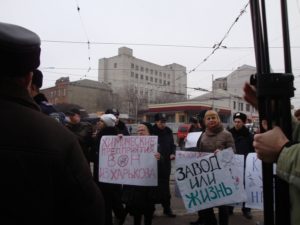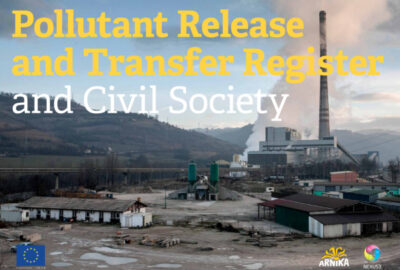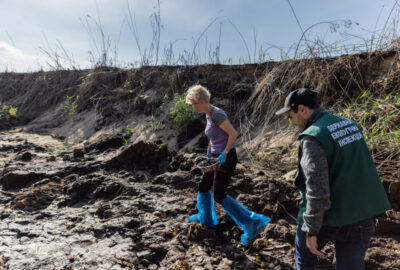Residents of the city of Kharkiv have suffered from extreme air pollution for many years. The most affected are the inhabitants of the Novobavarskyi district in the western part of the city. The two largest polluters are located in the valley at the confluence of the Udy and Lopan rivers: The Kharkiv Coke Plant, built in the 1930s with technology that is now extremely obsolete, and the Termolife Mineral Wool Plant put into operation in 2006. Both plants have the same owners.
The irritating odor, however, can be smelled far beyond the boun
daries of the district. A poisonous cocktail, every day. The situation is worst at night when the smell finds its way into apartments even though their windows are closed. According to data published by the Kharkov journal (Civic Position) in May 2017, the plants emit more than 800 tons of poisonous substances per year: 240 tons of sulfur dioxide, 50 tons of hydrocyanic acid, 200 tons of formaldehyde and other carcinogenic substances. In this city with a population of 1,439,036, every year 6,000 people die of cancer.
“In my house, 12 neighbours have died of cancer in the last 5 years,” says Elena Reshetko, a pensioner and resident of the Novobavarskyi district. She can see the Kharkiv Coke Plant from the balcony of the panel house where she has lived for 32 years. Reshetko encouraged many neighbors from the district to come together when she founded the Ekocid NGO in 2013. Since 2012 she has been trying to sue for damage to her health and violation of the right to live in a safe environment. Reshetko suffers from asthma, like her daughter. Her grandson was diagnosed with a blood disorder. However, the court hasn’t reached a verdict yet because of the lack of evidence of the link between the diseases and the pollution emitted by the plants into the air.
Shocking diseases statistics
Elena Reshetko has attempted to collect this evidence on her own for many years. Together with other activists, she requested official statistics from the Kharkiv clinics for different types of illnesses of adults and children in the years 2010, 2011, 2012 and 2013, and then examined the situation in different parts of the city.
When comparing Kharkiv Clinic No. 22 in the Chervonozavodskyi district (which is adjacent to the Zhovtenyi district, where the Kharkiv Coke Plant and Termolife are situated), with Kharkov Clinic No. 9 located 10 km from the plants, it turned out that occurences of pulmonary and bronchial disease in adults is almost 3078 times higher than those in the area distant from the city. For other diseases, the difference is 15-20 times higher. Diseases of the blood, skin diseases, the circulatory system and abnormalities in children in the affected area are 4 times higher than in the remote area. Children born with birth defects ranging from cerebral palsy, bronchial asthma, diseases of the circulatory system and deaf-muteness are 4.5 times higher per year in the area affected by the plants. Statistics for adult mortality demonstrated that death from cancer in the emission zone for the period from 2003 is 40 times higher, in contrast to the indicators of the remote area of the city.
The inhabitants turned to the authorities, organized demonstrations, wrote petitions and open letters to the governor, and in 2012 they blocked the track used for bringing the coal to the plant. And even though this long struggle yielded no results, activists were soon being intimidated: Reshetko received death threats, and one the door of her apartment was glued shut. Because the plant employs about 700 people, not all the Novobavarskyi district residents who are exposed to extreme pollution support the activists.
Rare mineral water used for coke production
The experimental laboratory of Giprokoks (Гипрококс), a state-owned firm, was built in Kharkov in 1932 as a coke research center. Its ovens ceased operation in 1952, but in 2003 new owners began coke production once more. They illegally gained access to a rare Novozhanov mineral water deposit. Now, potable publicly-owned mineral water is used in large volumes for coke quenching. Located 8 kilometers from the Kharkiv Coke Plant, the Berminvody, Rosha and Ray-Elenovka sanatoriums have mineral water with a similar composition.
Untreated wastewater from the Kharkiv Coke Plant issues from the back of the plant, which is guarded with armed security, polluting the soil of the territory of the mineral deposit and the Udy River. Thus we have a paradoxical situation where rare water is used for coke production, while ordinary Kharkiv people pay for drinking water at the price of 9.00 UAH per cubic meter.
“The production is daily and uninterrupted. Dioxins, hydrocyanic acid, phenol, sulfur dioxide, nitrogen dioxide, formaldehyde, benzene, naphthalene, and other highly toxic substances formed during the coke and mineral wool production are immediately reflected in mortality statistics. The plants are situated in the lowlands, so dangerous substances accumulate in the valley and the inhabitants have to breathe them. We observe here all the symptoms of environmental disaster: pollution of the atmosphere, water and soil,” says Reshetko.
The source of the drinking water falls under the State Geological and Mineral Resources Survey (Derzhgeonadra) of Ukraine, where the activists sent an official request for the release of contracts allowing access to the area of the rare water deposit, along with the necessary authorization. Derzhgeonadra replied that no rental permit or permit for the construction of facilities was ever been issued to either plant, and this was later confirmed by Oktjabr’s court in Kharkiv.
In 2016, Kharkiv State Environmental Inspection carried out an inspection in the Kharkiv Coke Plant and noted a large number of violations of the law. However, the fine of 14 millions hrivnas has been never paid by the owners.
Investigation on the Kharkiv coke plant case made by 24 Kanal: https://www.youtube.com/watch?v=35aeOMvG534








